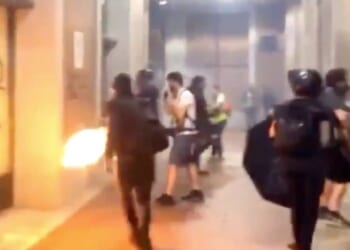
Hello, I’m Alex Swoyer. Welcome to the Washington Times’ interview with Todd Lyons, Director of Immigration and Customs Enforcement. The man who oversees the government’s deportation force, ICE, is at the center of the immigration debate right now, clashing with sanctuary cities and anti-ICE protesters as it moves to carry out President Trump’s plans for mass deportations.
[SWOYER] One of the important topics that I’m sure you’re asked a lot about and that we’ve covered a lot at the Washington Times is about the explosion under the Biden administration of unaccompanied minor children. And the tragic events that have happened with the lost children. So I know HSI has been trying to track them down. Can you give us any update on those numbers? What’s the universe of kids you’re looking for? What percentage are you able to locate? Should we expect to see a crush of prosecutions? What’s your update there for the lost kids?
[LYONS] Our big thing right now is to really make sure, first off, that we can locate and find these children and make sure they’re safe, number one. Number two, we want to make sure that ones that are with sponsors that aren’t their family, we get them back home to their families. So, Homeland Security investigation goes out every day. Every day they’re out there checking on last known addresses, following up on any type of case information we have. You know, we’ve seen in cases in Massachusetts and in New Jersey where we’ve rescued children from sponsors that either were sexually abusing them, put into work, whether it be forced labor, slave labor. And that’s what we’re really trying to focus on. Because unfortunately, you Unfortunately, you saw the stories where people were coming across, are young kids coming to the border with just a phone number or a name tape to their or pin to their jacket. So we have to go back out there and locate these children.
Now, what’s hard for us is, Homeland Security Investigations agents are going to, whether it be last known shelters, residents, or in some cases, schools. Some cases, we only have the last known school address. Yet we’re being accused of going to schools and rounding up children; all we’re trying to do is locate these poor kids. And that’s the last known address we have. Yet you have some media outlets or some elected officials that will put that spin on it, that this great mission that we’re trying to do to locate and find and help these poor children is being torn apart in the news or for political rhetoric.
[SWOYER] Is there a percentage of cases, or just from your experience, were you surprised with the sheer number of placements that were endangering them?
[LYONS] We were, especially when we started to learn about super sponsors, where you sometimes have 30, 40 children at one address. And then you go there, and that address is a 7-Eleven. Or it just doesn’t exist anymore. So then you have to wonder, where did these children go? But then also that the federal government was subsidizing these non-governmental organizations. They were supposed to be taking care of these children. So now under Health and Human Services, our folks that are working with HSI trying to go and look into these organizations and really try to hammer it out. Where do these poor kids go?
[SWOYER] As a parent, it’s very scary, heartbreaking. You can’t imagine what were they coming from, that they were put in that situation, just across the board in the first place. And now where they are, now that they have arrived, we can’t find them.
Secretary Noem mentioned that there’s been a thousand percent increase in assaults on your officers. Do you have totals? And where have you seen the biggest increases in assaults? Are these at-large arrests or jail handover situations? And some of the illegals have always resisted arrest. Our editor who covers immigration, Stephen Dinan, mentioned that he’s seeing more U.S. citizens also arrested. Were U.S. citizens interfering in arrests before and the previous administration just didn’t prosecute them? Or is this an increase recently because of political rhetoric?
[LYONS] I think it’s both. So I can tell you from my tenure in the director’s chair. We started off at like 500%, 600%, 800. You know, we do say now it’s over 1,000 percent. And I want to say that number’s probably about a month old. I bet it’s higher than that now. And I think it’s a mixture, right? So, to go to the first point about where we’re seeing the assaults, we’re seeing the assaults at-large arrests. One thing that we always say, especially in the sanctuary jurisdictions, is ICE wouldn’t have to go out and make these arrests if sanctuary jurisdictions cooperated with us. You would send out one or two agents to a jail or to a local police department where that agency has already deemed that person a public safety threat. So they’re already behind bars. Safe environment, not only for my officers, those officers, the criminal alien themselves, but instead now we have to go out into the community.
[SWOYER] If that was California, Illinois, if they allowed your officers to come into their prisons?
[LYONS] You wouldn’t see this. You wouldn’t see the violence on the streets. And that’s what’s really frustrating for me is the fact that you do talk about that political rhetoric. And you do have governors like Governor Newsom, who the night before the sniper attack in Dallas went out and said, “Well, I would push back against ICE. I would resist ICE.”
Watch the video for the full conversation.











